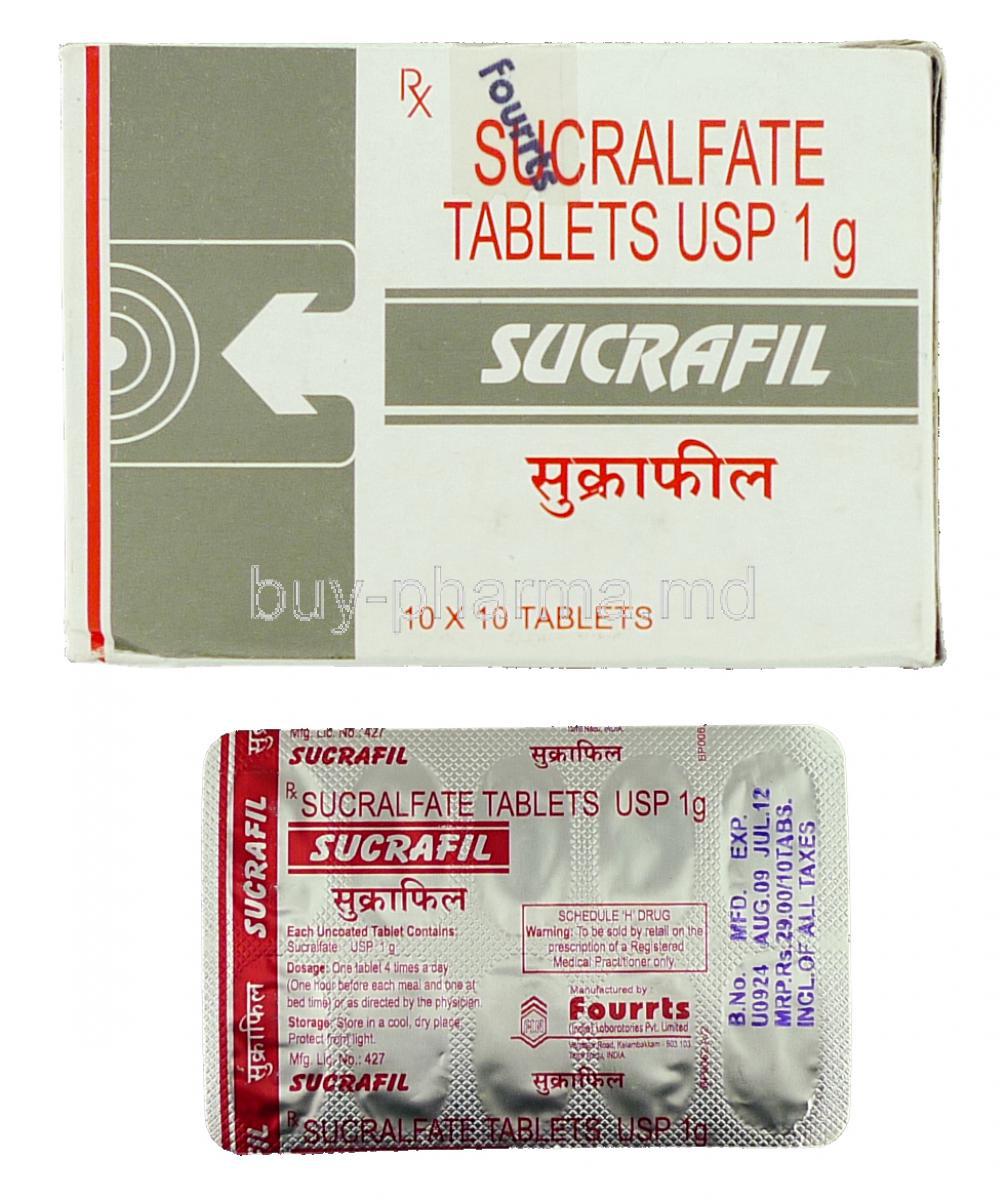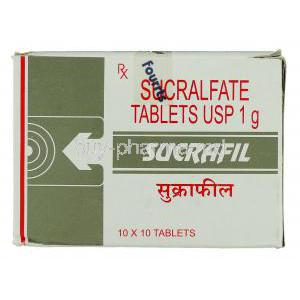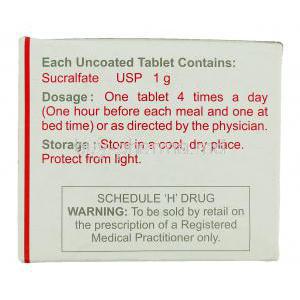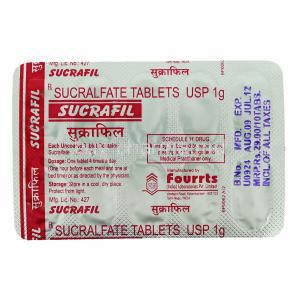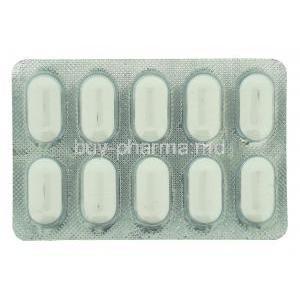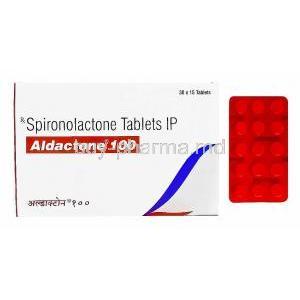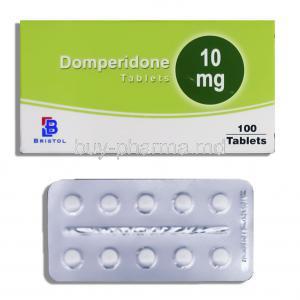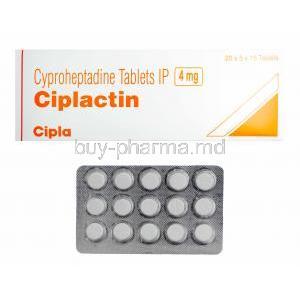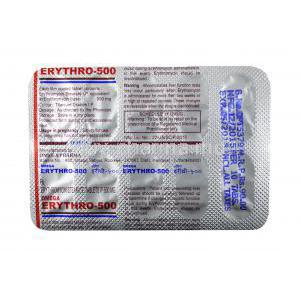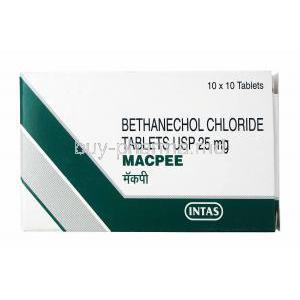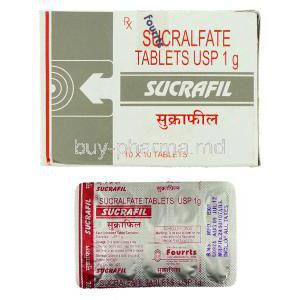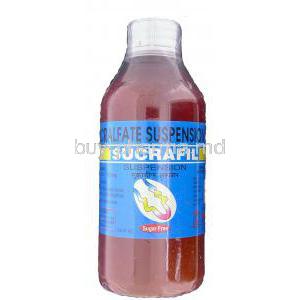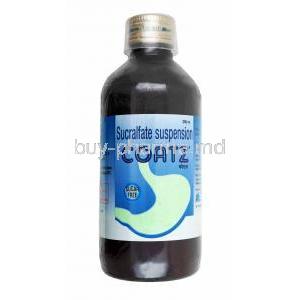Introduction
Overview of Sucrafil and its Active Ingredient Sucralfate
Sucrafil contains the active compound sucralfate, a locally acting gastrointestinal protectant. It is widely recognized for its ability to coat the stomach lining and provide relief in acid-related conditions. The medication is primarily used in the management of ulcers, gastritis, and reflux disorders where mucosal protection is paramount.
Historical Background and Approval Timeline
Sucralfate was first introduced in the late 20th century as a novel mucosal-protective agent. In 1981, the U.S. Food and Drug Administration granted approval, marking the beginning of its clinical use in ulcer management. Since then, it has remained a reliable therapy across various global markets, particularly valued for its non-systemic mechanism.
Therapeutic Classification and Clinical Relevance
Sucrafil belongs to the class of gastroprotective agents. Unlike acid suppressants, it does not alter gastric acid production but instead fortifies the mucosal barrier. This classification makes it highly relevant in patients requiring localized action without systemic involvement.
Composition of Sucrafil
Active Ingredient: Sucralfate
The primary therapeutic agent in Sucrafil is sucralfate, an aluminum salt of sucrose sulfate. It is responsible for forming protective complexes with proteins in ulcerated tissue.
Available Formulations: Suspension, Tablets
- Oral suspension: Frequently prescribed for patients with difficulty swallowing tablets or requiring uniform coating of the gastric mucosa.
- Tablets: Designed for convenient dosing and long-term use.
Inactive Ingredients and Excipients
Excipients may include flavoring agents, stabilizers, and suspending agents in the liquid formulation. These components enhance palatability and maintain drug stability.
Pharmacological Properties and Absorption Profile
Sucralfate exhibits minimal systemic absorption. Instead, its activity is localized in the gastrointestinal tract, where it adheres strongly to ulcer bases. Less than 5% of the drug is absorbed, minimizing systemic adverse effects.
Sucralfate and pantoprazole
Sucralfate and pantoprazole can be taken together, but you should take pantoprazole at least 30 minutes before sucralfate to ensure they are effective, as pantoprazole needs an acid environment and sucralfate can become less effective if it binds to the acid-reducing pantoprazole instead of the ulcer site.
Sucralfate vs omeprazole
Sucralfate forms a protective barrier over ulcers, while omeprazole (a proton pump inhibitor) blocks stomach acid production, making it more effective at healing severe ulcers. Omeprazole is generally superior for symptom relief and healing rates, especially in severe cases, but sucralfate provides a physical protection that can be beneficial.
Carafate vs Sucralfate
Sucralfate is a medication that treats stomach ulcers. It forms a barrier over the ulcer. This protects it from stomach acid and helps it heal. The brand name of this medication is Carafate
How Sucrafil Works: Sucralfate Mechanism of action
Protective Barrier Formation on Gastric Mucosa
Upon exposure to gastric acid, sucralfate undergoes polymerization to form a viscous, sticky substance. This complex binds to ulcer craters, creating a mechanical barrier.
Binding to Ulcerated Tissues and Protection from Acid, Pepsin, and Bile Salts
The barrier shields damaged mucosa from corrosive gastric contents, bile acids, and proteolytic enzymes. This permits cellular regeneration and accelerates tissue repair.
Stimulation of Prostaglandin and Bicarbonate Secretion
Sucralfate indirectly stimulates endogenous prostaglandin production and enhances bicarbonate secretion, augmenting mucosal defense and buffering acid exposure.
Non-Systemic Mode of Action and Its Significance
Because the drug acts locally, systemic side effects are rare. This property makes sucralfate suitable for patients with comorbidities who cannot tolerate systemic acid-suppressive therapy.
Sucralfate Uses
- Sucralfate for ulcers: Proven efficacy in accelerating healing and reducing recurrence.
- Gastric ulcer management: Forms protective lining and enhances mucosal recovery.
- Gastroesophageal reflux disease (GERD): Provides symptomatic relief by reducing acid injury.
- Stress-induced mucosal damage prevention: Common in critically ill patients at risk of stress ulcers.
- Adjunctive therapy in peptic ulcer disease: Often used alongside proton pump inhibitors or H2 antagonists.
Off-Label Uses of Sucralfate
- Radiation-induced esophagitis and oral mucositis: Provides soothing mucosal protection during cancer therapy.
- Prevention of NSAID-induced gastropathy: Shields mucosa from NSAID-related erosions.
- Treatment of stomatitis and aphthous ulcers: Used topically or orally to reduce discomfort.
- Bile reflux gastritis: Beneficial in managing mucosal irritation caused by bile reflux.
- Sucralfate for gastritis: Supports mucosal regeneration in persistent gastritis cases.
- Prophylaxis of gastrointestinal bleeding in critically ill patients: Applied in intensive care protocols for ulcer prevention.
- sucralfate for horses: Sucralfate for horses treats gastric ulcers by protecting the stomach lining, reducing pain, and promoting healing.
Sucralfate Dosage
Sucralfate Dosage for Adults: Schedules for Ulcers and GERD
The usual adult dose for duodenal ulcer healing is 1 g taken four times daily, preferably before meals and at bedtime. GERD treatment may require individualized adjustments.
Dosage for Prophylaxis of Ulcer Recurrence
Maintenance therapy often involves 1 g taken twice daily to reduce recurrence risk.
Sucralfate dosage for Gastritis
Adult: Usual dose: 1 g 4 times daily for 4-8 weeks. Doses to be taken 1 hour before or 2 hours after meals.
Pediatric Dosing Guidelines and Limitations
Pediatric data remain limited. Use is typically reserved for selected cases under specialist supervision, with dosage calculated by body weight.
Administration with or without Meals
Optimal effect is achieved when administered on an empty stomach, as food can interfere with binding efficiency.
Duration of Therapy and Tapering Considerations
Therapy usually continues for 4 to 8 weeks. In recurrent cases, prolonged prophylaxis may be considered with careful monitoring.
Side Effects of Sucrafil
Side effects of Sucralfate
Sucrafil is generally well tolerated due to minimal systemic absorption. Most side effects are localized to the gastrointestinal system.
Common Side Effects
- Constipation
- Dry mouth
- Upset stomach
- Dizziness
Serious Adverse Effects
- Bezoar formation, particularly in patients with gastric stasis
- Hypersensitivity reactions, though rare
- Aluminum toxicity in individuals with renal impairment
Frequency and Severity Based on Dosage and Population
Adverse events are dose-related and more frequent in elderly patients or those with impaired renal function. Constipation is the most commonly reported side effect.
Sucralfate Interactions
Reduced Absorption of Concomitant Medications
Sucralfate can reduce the bioavailability of several drugs, including:
- Fluoroquinolones
- Tetracyclines
- Digoxin
- Phenytoin
- Warfarin
Interaction with Antacids and Proton Pump Inhibitors
Concomitant use with antacids may diminish sucralfate’s efficacy. Proton pump inhibitors may also alter the gastric environment, impacting binding capacity.
Timing Strategies to Minimize Interactions
It is recommended to administer interacting drugs at least 2 hours before sucralfate. This strategy reduces competition for absorption sites.
Clinical Significance of Polypharmacy with Sucralfate
Patients on multiple medications must be carefully managed to avoid therapeutic compromise. Scheduling and monitoring are essential to ensure optimal outcomes.
Warnings and Contraindications
Contraindication in Patients with Hypersensitivity to Sucralfate
Sucrafil should not be administered to individuals with known hypersensitivity to sucralfate or any of its excipients. Even rare allergic reactions may manifest as rash, pruritus, or anaphylaxis, requiring immediate discontinuation.
Caution in Patients with Chronic Renal Failure (Aluminum Accumulation Risk)
Since sucralfate contains aluminum, patients with chronic renal impairment are at increased risk of aluminum accumulation. This can lead to encephalopathy, osteomalacia, or anemia. Monitoring is critical in this population.
Special Warnings for Long-Term Use and Malnourished Patients
Extended administration may reduce the absorption of essential nutrients. Malnourished individuals or those with compromised gastrointestinal absorption require heightened vigilance to prevent deficiencies and complications.
Foods to avoid while taking sucralfate
Avoid taking antacids, sucralfate, dairy products, and iron and zinc supplements within two hours of taking this medication.
Sucralfate OTC alternative
OTC antacids like calcium carbonate (Tums), H2 blockers such as famotidine (Pepcid) or cimetidine (Tagamet), or proton pump inhibitors (PPIs) like omeprazole (Prilosec)
Careful Administration and Precautions
Monitoring in Patients with Renal Impairment
Close surveillance of renal parameters and serum aluminum levels is advisable in patients with impaired kidney function. Adjustments in therapy or alternative treatments should be considered if accumulation is suspected.
Risk Management in Patients Requiring Multiple Medications
Polypharmacy heightens the chance of drug interactions due to sucralfate’s binding properties. Strategies to minimize these risks include:
- Spacing administration of other medications at least two hours apart
- Regular review of medication regimens
- Therapeutic monitoring when necessary
Importance of Hydration to Avoid Constipation
Constipation is the most common side effect. Adequate fluid intake and dietary fiber can mitigate this discomfort and improve tolerance during therapy.
Safety in Prolonged Therapy
Although well tolerated, long-term use necessitates periodic evaluation of gastrointestinal health and nutritional status to ensure safety and efficacy remain uncompromised.
Use in Special Populations
Administration to Elderly Patients
Altered Pharmacokinetics and Sensitivity
Elderly patients may exhibit altered drug handling due to age-related physiological changes. Reduced gastric motility and renal clearance increase sensitivity to adverse reactions.
Risk of Constipation and Drug Interactions
Constipation and pharmacological interactions are more prevalent in older adults, particularly those with multiple comorbidities requiring concurrent medications.
Dose Adjustment Considerations
Although formal dose reductions are not typically required, careful titration and monitoring may be prudent to balance efficacy with tolerability.
Administration to Pregnant Women and Nursing Mothers
Safety Data During Pregnancy
Animal studies indicate no significant teratogenic effects. Human data remain limited but generally suggest safety when used under medical guidance.
Placental Transfer and Teratogenicity Profile
Systemic absorption is negligible, minimizing placental transfer. The risk of congenital abnormalities is considered low.
Use During Breastfeeding and Excretion in Breast Milk
Excretion into breast milk has not been well established, though systemic exposure is minimal. Caution is advised, and infants should be observed for gastrointestinal disturbances.
Administration to Children
Limited Safety and Efficacy Data in Pediatrics
Pediatric studies are scarce, and dosing is often extrapolated from adult protocols. Use should be restricted to situations with clear therapeutic justification.
Indications Where Pediatric Use May Be Justified
Situations such as peptic ulcers or severe gastritis may warrant use, particularly in specialized care settings under close supervision.
Precautions in Long-Term Therapy in Children
Extended use in children necessitates careful monitoring to avoid nutritional deficiencies or unintended side effects, including constipation and bezoar formation.
Overdosage and Toxicity
Symptoms of Overdose: GI Disturbances, Bezoar Risk
Excessive intake may result in gastrointestinal upset, including nausea, vomiting, or constipation. Rarely, bezoars may develop due to drug accumulation in the stomach.
Aluminum Toxicity in Renal Impairment
Patients with reduced kidney function are particularly vulnerable to aluminum overload, which may present as neurological or bone disorders.
Emergency Management Strategies
In overdose scenarios, prompt gastric lavage, discontinuation of therapy, and symptomatic management are critical. Medical supervision should be sought immediately.
Supportive and Symptomatic Treatment
Hydration, electrolyte correction, and close monitoring of renal function are key supportive measures. In severe cases, dialysis may be necessary to reduce aluminum levels.
Handling and Storage Precautions
Proper Storage Temperature and Light Protection
Sucrafil should be stored at controlled room temperature, away from excessive moisture and direct sunlight. Light protection ensures product stability.
Suspension vs. Tablet Stability
The suspension requires thorough shaking before use and should not be frozen. Tablets offer greater stability but must be kept in tightly closed containers.
Handling Precautions to Maintain Product Integrity
Hands should be dry when handling tablets to avoid degradation. Suspension bottles should be capped securely after each use.
Shelf Life and Expiration Considerations
Products should be discarded after the expiration date, as potency and safety cannot be guaranteed beyond the indicated shelf life.
Sucrafil, Sucralfate FAQ
- What is Sucrafil used for?
- Is Sucrafil good for gas?
- How long can I take Sucrafil?
- Can Sucrafil heal stomach ulcers?
- Can I take Sucrafil on an empty stomach?
- How long does it take for Sucrafil to work?
- What are the side effects of Sucrafil syrup?
- Is Sucrafil good for gastritis?
- What is the drug sucralfate used for?
- Is sucralfate the same as Gaviscon?
- When should you take sucralfate?
- Does sucralfate get rid of acid reflux?
- Can sucralfate reduce stomach pain?
- How quickly does sucralfate work?
- Which is better, omeprazole or sucralfate?
- What should you avoid when taking sucralfate?
- Which is better, antacid or sucralfate?
- What is a good substitute for sucralfate?
- What is the most common side effect of sucralfate?
- Can you take omeprazole and sucralfate together?
- Does sucralfate reduce gas?
- Is sucralfate safe for kidneys?
- Can sucralfate heal gastritis?
- Can I take pantoprazole and sucralfate together?
- Does sucralfate cause gas?
- Can I go to bed after taking sucralfate?
- Does sucralfate treat GERD?
- What is the warning for sucralfate?
- Can I take Gaviscon with sucralfate?
- How long to take sucralfate for gastritis?
- Is sucralfate good for chronic gastritis?
What is Sucrafil used for?
Sucrafil Oral Suspension is utilized for the treatment of intestinal ulcers. Sucrafil Oral Suspension functions by decreasing the acid production in your stomach, which prevents additional harm to the ulcer and allows it to heal naturally. Sucrafil Oral Suspension also alleviates pain and bleeding linked to intestinal ulcers.
Is Sucrafil good for gas?
Yes
How long can I take Sucrafil?
As long as your doctor recommends
Can Sucrafil heal stomach ulcers?
Yes
Can I take Sucrafil on an empty stomach?
Yes
How long does it take for Sucrafil to work?
1-2 hours
What are the side effects of Sucrafil syrup?
constipation, dizziness, drowsiness, dry mouth, blurred vision, and diarrhea
Is Sucrafil good for gastritis?
Yes
What is the drug sucralfate used for?
Sucralfate is prescribed to both treat and prevent duodenal ulcers, along with other conditions identified by your doctor. It functions by creating a protective barrier over the ulcer. This shield safeguards the ulcer from stomach acid, facilitating its healing. Sucralfate is composed of an aluminum salt.
Is sucralfate the same as Gaviscon?
No
When should you take sucralfate?
2 hours after or 1 hour before meals.
Does sucralfate get rid of acid reflux?
Sucralfate can aid in alleviating GERD symptoms and promoting healing in your esophagus.
Can sucralfate reduce stomach pain?
Yes
How quickly does sucralfate work?
1 to 2 hours after you take it
Which is better, omeprazole or sucralfate?
Sucralfate
What should you avoid when taking sucralfate?
If you're taking sucralfate, you should avoid eating for 1 hour before, and 2 hours after taking the medication.
Which is better, antacid or sucralfate?
The sucralfate suspension offered a safe and effective method for stress ulcer prophylaxis, which could be more favorable than antacid therapy due to its impact on gastric and pulmonary microbes.
What is a good substitute for sucralfate?
What is the most common side effect of sucralfate?
Constipation
Can you take omeprazole and sucralfate together?
Take omeprazole at least 30 minutes before sucralfate.
Does sucralfate reduce gas?
Yes
Is sucralfate safe for kidneys?
Those who have significant renal impairment should use sucralfate with caution, as it could result in aluminum accumulation.
Can sucralfate heal gastritis?
Yes
Can I take pantoprazole and sucralfate together?
Take pantoprazole at least 30 minutes prior to sucralfate.
Does sucralfate cause gas?
Yes
Can I go to bed after taking sucralfate?
Yes
Does sucralfate treat GERD?
Yes
What is the warning for sucralfate?
Sucralfate can lead to allergic reactions that may be severe. Discontinue use of sucralfate and seek immediate assistance if you experience any of the following signs of a serious allergic reaction.
Can I take Gaviscon with sucralfate?
Combining sucralfate with aluminum hydroxide may reduce the effectiveness of sucralfate.
How long to take sucralfate for gastritis?
4-8 weeks
Is sucralfate good for chronic gastritis?
Acts to effectively seal the ulcer base and to prevent the gastritis from worsening.

